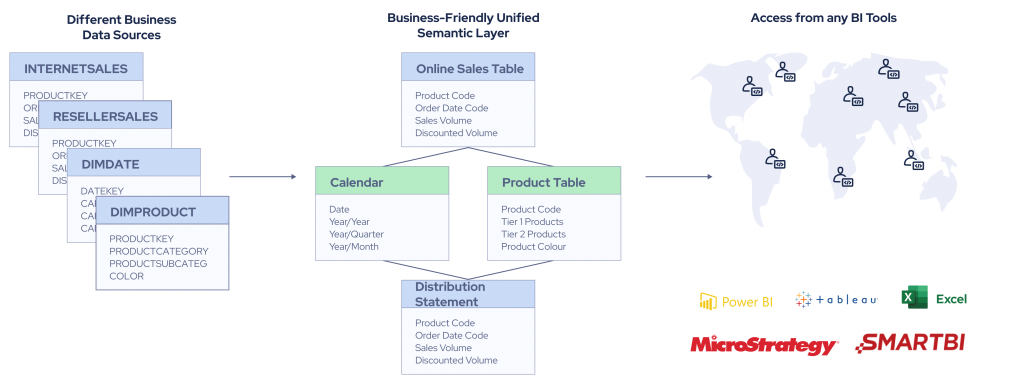Ⓒ 2023 Kyligence, Inc. All rights reserved.
Semantic Layer in Data Warehouse

What is Semantic Layer?
Semantic layer is a virtual layer in a data warehouse that provides a common business language for end-users to access data. It acts as a bridge between the physical data and the end-users, allowing them to easily retrieve and analyze data without needing to understand the underlying data structure. The semantic layer works by mapping the physical data to a logical model that is easier to understand. It is important in data warehousing because it simplifies data access, improves data quality, and reduces the need for end-users to rely on IT for data retrieval.
Example of Semantic Layer
Simplifying Data Access
A semantic layer can simplify data access by providing a common business vocabulary and abstracting the complexity of the underlying data sources. It acts as a bridge between the technical data structures and the business users who need to access the data. With a semantic layer, users can query the data using familiar business terms and concepts, rather than having to understand the underlying data structures and query languages. This makes it easier for business users to access the data they need, without requiring technical expertise or assistance from IT.
Example of Semantic Layer in Action
For example, a retail company might use a semantic layer to provide a unified view of customer data from multiple sources, such as point-of-sale systems, online transactions, and customer service interactions. Business users could then query this data using terms like 'customer lifetime value' or 'purchase history', without needing to know the technical details of each data source. The benefits of using a semantic layer include improved data quality, faster time-to-insight, and increased agility in responding to changing business needs.
Creating a Semantic Layer
Steps Involved in Creating a Semantic Layer
Creating a semantic layer involves several steps. The first step is to identify the data sources that will be used to populate the data warehouse. The next step is to define the business rules and metrics that will be used to analyze the data. Once the business rules and metrics have been defined, the data can be modeled and mapped to the semantic layer. The final step is to create the semantic layer itself, which involves defining the relationships between the data elements and creating the necessary hierarchies and aggregations.
Best Practices and Challenges
When creating a semantic layer, it is important to follow best practices to ensure that the layer is efficient and effective. Best practices include using a standardized naming convention, creating a logical data model, and using a metadata repository to manage the layer. However, there are also challenges to creating a semantic layer, such as ensuring data quality, managing complex hierarchies, and dealing with changing business requirements. Overcoming these challenges requires careful planning, collaboration between IT and business stakeholders, and a willingness to adapt to changing circumstances.
Implementing a Semantic Layer
How to Implement a Semantic Layer
To implement a semantic layer, start by identifying the business requirements and data sources. Then, design the semantic model and create the necessary mappings to transform the data into the desired format. Next, implement the semantic layer using a tool or platform that supports the chosen technology stack. Finally, test and validate the semantic layer to ensure it meets the business requirements and provides accurate and consistent data.
Technologies and Best Practices
Technologies commonly used to implement a semantic layer include SQL, OLAP, ETL tools, and BI platforms. Best practices for implementing a semantic layer include using a standardized naming convention, documenting the semantic model and data sources, and ensuring data quality and consistency. It is also important to involve business stakeholders in the design and testing of the semantic layer to ensure it meets their needs and provides actionable insights.
Kyligence: Metric-driven approach to build a semantic layer
In conclusion, the semantic layer plays a crucial role in data warehousing by providing a common language for business users and IT professionals to communicate and understand data. It simplifies the data access process and enables faster decision-making. By using a semantic layer, organizations can improve data quality, reduce maintenance costs, and increase efficiency. Overall, the benefits of a semantic layer are significant and can lead to better business outcomes.
At Kyligence, we recognize the immense value provided by a semantic layer. Based on years of experience working with our valued customers, we have concluded that a platform that converts technical data into business metrics is the best way to enable business users to explore, understand, and gain insights.
A unified metrics layer or metric store, built through a graphical user interface (GUI), empowers business users to precisely define business terms and calculation logic. This creates a universal data language for all businesses to align and collaborate in one convenient location, ensuring that everyone in the organization is on the same page.
If you are interested in the semantic layer solution Kyligence provides, here is what you can learn more from the
1. Build your semantic layer using Kyligence Zen.
2. Check out more articles about Semantic Layer: https://kyligence.io/blog/semantic-layer-the-bi-trend-you-dont-want-to-miss/
Start your data journey today
